Potrebujeme váš súhlas na využitie jednotlivých dát, aby sa vám okrem iného mohli ukazovať informácie týkajúce sa vašich záujmov. Súhlas udelíte kliknutím na tlačidlo „OK“.
ASTM D6286-12
Standard Guide for Selection of Drilling Methods for Environmental Site Characterization
Automaticky preložený názov:
Štandardné Príručka pre výber Vŕtacie metód pre životné prostredie Site charakterizácia
NORMA vydaná dňa 1.9.2012
Informácie o norme:
Označenie normy: ASTM D6286-12
Poznámka: NEPLATNÁ
Dátum vydania normy: 1.9.2012
Kód tovaru: NS-34526
Počet strán: 17
Približná hmotnosť: 51 g (0.11 libier)
Krajina: Americká technická norma
Kategória: Technické normy ASTM
Kategórie - podobné normy:
Ostatní normy týkající se jakosti půdy
Zařízení pro vrtání a rubání
Anotácia textu normy ASTM D6286-12 :
Keywords:
drilling, environmental, groundwater, monitoring wells, site characterization, ICS Number Code 13.080.99 (Other standards related to soil quality), 73.100.30 (Equipment for drilling and mine excavation)
Doplňujúce informácie
| Significance and Use | ||||||||
|
4.1 The selection of particular method(s) for drilling monitoring wells (see Table 1) requires that specific characteristics of each site be considered. These characteristics would include, but are not limited to, the ambient hydrogeologic parameters and conditions existing at the site. This guide is intended to make the user aware of some of the various drilling methods available and the applications, advantages and disadvantages of each with respect to determining groundwater chemistry and other hydrogeologic properties data. Drilling Method
|
Drilling |
Casing |
Type of |
Typical |
Typical |
Samples |
Coring |
Reference |
|
Power auger |
none, water, mud |
yes |
soil, weathered rock |
<45 (150) |
12.7–55 (5–22) |
S, F |
yes |
6.2 |
|
|
|
|
|
|
|
|
|
|
|
Power auger |
water, mud |
no |
soil, weathered rock |
<45 (150) |
5–25 (2–10) |
s |
yes |
6.3 |
|
|
|
|
|
|
|
|
|
|
|
Power bucket auger |
none, water (below water table) |
no |
soil, weathered rock |
<45 (150) |
45–120 (18–48) |
S |
yes |
6.4 |
|
|
|
|
|
|
|
|
|
|
|
Hand auger |
none |
no |
soil |
<20 (70) (above water table only) |
5–15 (2–6) |
S |
yes |
6.5 |
|
|
|
|
|
|
|
|
|
|
|
Direct fluid rotary |
water, mud |
yes |
soil, rock |
>300 (1000) |
5–90 (2–36) |
S, R |
yes |
7.3 |
|
|
|
|
|
|
|
|
|
|
|
Direct air rotary |
air, water, foam |
yes |
soil, rock |
>460 (1500) |
5–90 (2–36) |
S, R, F |
yes |
7.4 |
|
|
|
|
|
|
|
|
|
|
|
DTH hammer |
air, water, foam |
yes |
rock, boulders |
<600 (2000) |
10–40 (4–16) |
R |
yes |
7.5.1 |
|
|
|
|
|
|
|
|
|
|
|
Wireline |
air, water, foam |
yes |
soil, rock |
>300 (1000) |
7.6–15 (3–6) |
S, R, F |
yes |
7.6 |
|
|
|
|
|
|
|
|
|
|
|
Reverse fluid rotary |
water, mud |
yes |
soil, rock |
<600 (2000) |
30–90 (12–36) |
S, R, F |
yes |
7.8 |
|
|
|
|
|
|
|
|
|
|
|
Reverse air rotary |
air, water, foam |
yes |
soil, rock |
>300 (1000) |
30–90 (12–36) |
S, R, F |
yes |
7.7 |
|
|
|
|
|
|
|
|
|
|
|
Cable tool |
water |
yes |
soil, rock |
<1500 (5000) |
10–60 (4–24) |
S, R, F (F–below water table) |
yes |
8 |
|
|
|
|
|
|
|
|
|
|
|
Casing-advancer |
air, water, mud |
yes |
soil, rock, boulders |
<600 (2000) |
5–40 (2–16) |
S, R, F |
yes |
9 |
|
|
|
|
|
|
|
|
|
|
|
Direct-push technology |
none |
yes |
soil |
Typical 6-7 |
3.8–7.6 (1.5–3) |
S, F |
yes |
10 |
|
|
|
|
|
|
|
|
|
|
|
Sonic (vibratory) |
none, water, mud, air |
yes |
soil, rock, boulders |
<150 (500) |
10–30 (4–12) |
S, R, F |
yes |
11 |
|
|
|
|
|
|
|
|
|
|
|
Jet percussion |
water |
no |
soil |
<15.0 (50) |
5–10 (2–4) |
S |
no |
12 |
|
|
|
|
|
|
|
|
|
|
|
Jetting |
water |
yes |
soil |
<15 (50) |
10 (4) |
S |
no |
12 |
1.1 This guide provides descriptions of various drilling methods for environmental site characterization along with advantages and disadvantages associated with each method discussed. A comprehensive description of these drilling methods can be found in individual ASTM standards, see Section 2. This guide is intended to aid in the selection of drilling method(s) for environmental soil and rock borings and the installation of monitoring wells and other water-quality monitoring devices.
1.2 This guide does not address methods of well construction, well development, or well completion. These topics are covered in other ASTM documents, see Section 1.3 This guide cannot address all possible subsurface conditions that may occur such as, geologic, topographic, climatic, or anthropogenic. Site evaluation for engineering, design, and construction purposes is addressed in Guide D420.
1.4 The values stated in SI units are to be regarded as the standard. Because dimensions of materials used in the drilling industry are given in inch-pound units by convention, rationalized inch-pound units also are used in this guide. Each system of units is to be regarded separately as standard.
1.5 This guide does not specifically address methods of lithologic sample collection, such as coring, that may require the use of a specific drilling method. Other ASTM guides should be consulted for sampling methods (see Guide D6169) and equipment necessary for specific projects.
1.6 This guide does not purport to comprehensively address all of the methods and the issues associated with drilling for environmental purposes. Users should seek qualified professionals for decisions as to the proper equipment and methods that would be most successful for their site investigation. Other methods may be available for drilling and qualified professionals should have flexibility to exercise judgment as to possible alternatives not covered in this guide. The guide is current at the time of issue, but new alternative methods may become available prior to revisions; therefore, users should consult with manufacturers or producers prior to specifying program requirements.
1.7 Pertinent guides addressing specific drilling methods, equipment and procedures are listed in 1.8 This standard does not purport to address all of the safety concerns, if any, associated with its use. It is the responsibility of the user of this standard to establish appropriate safety and health practices and determine the applicability of regulatory limitations prior to use.
1.9 This guide offers an organized collection of information or a series of options and does not recommend a specific course of action. This document cannot replace education and experience and should be used in conjunction with professional judgment. Not all aspects of this guide may be applicable in all circumstances. This ASTM standard is not intended to represent or replace the standard of care by which the adequacy of a given professional service must be judged, nor should this document be applied without consideration of a project's many unique aspects. The word “Standard” in the title of this document means only that the document has been approved through the ASTM consensus process.
|
Standard Guide for Use of Direct Air-Rotary Drilling for Geoenvironmental Exploration and the Installation of Subsurface Water-Quality Monitoring Devices |
|
|
Standard Guide for Use of Dual-Wall Reverse-Circulation Drilling for Geoenvironmental Exploration and the Installation of Subsurface Water-Quality Monitoring Devices |
|
|
Standard Guide for Site Characterization for Environmental Purposes With Emphasis on Soil, Rock, the Vadose Zone and Groundwater (Withdrawn 2013) |
|
|
Standard Test Method for Standard Penetration Test (SPT) and Split-Barrel Sampling of Soils |
|
|
Standard Guide for Planning and Conducting Geotechnical Borehole Geophysical Logging |
|
|
Standard Practice for Design and Installation of Ground Water Monitoring Wells in Aquifers |
|
|
Standard Practice for Thick Wall, Ring-Lined, Split Barrel, Drive Sampling of Soils |
|
|
Standard Practice for Rock Core Drilling and Sampling of Rock for Site Exploration (Withdrawn 2023) |
|
|
Standard Practice for Thin-Walled Tube Sampling of Soils for Geotechnical Purposes |
|
|
Standard Test Method for Marsh Funnel Viscosity of Clay Construction Slurries |
|
|
Standard Guide for Selecting Surface Geophysical Methods |
|
|
Standard Guide for Selection of Soil and Rock Sampling Devices Used With Drill Rigs for Environmental Investigations |
|
|
Standard Practice for Using Hollow-Stem Augers for Geotechnical Exploration and Soil Sampling |
|
|
Standard Guide for Direct-Push Groundwater Sampling for Environmental Site Characterization |
|
|
Standard Guide for Use of Casing Advancement Drilling Methods for Geoenvironmental Exploration and Installation of Subsurface Water-Quality Monitoring Devices |
|
|
Standard Guide for Use of Hollow-Stem Augers for Geoenvironmental Exploration and the Installation of Subsurface Water-Quality Monitoring Devices |
|
|
Standard Guide for Use of Direct Rotary Drilling with Water-Based Drilling Fluid for Geoenvironmental Exploration and the Installation of Subsurface Water-Quality Monitoring Devices |
|
|
Standard Guide for Use of Cable-Tool Drilling and Sampling Methods for Geoenvironmental Exploration and Installation of Subsurface Water-Quality Monitoring Devices |
|
|
Standard Practice for Description and Identification of Soils (Visual-Manual Procedures) (Includes all amendments and changes 4/4/2018). |
|
|
Standard Guide for Use of Direct Rotary Wireline Casing Advancement Drilling Methods for Geoenvironmental Exploration and Installation of Subsurface Water-Quality Monitoring Devices |
|
|
Standard Guide for Site Characterization for Engineering Design and Construction Purposes |
|
|
Standard Terminology Relating to Soil, Rock, and Contained Fluids |
Podobné normy:
Historická
1.11.2009
Historická
1.8.2013
Historická
15.1.2013
Historická
1.5.2014
Historická
1.5.2011
Historická
1.11.2011


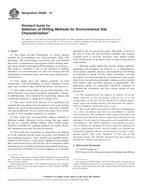
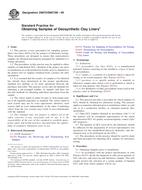 ASTM D6072/D6072M-09..
ASTM D6072/D6072M-09..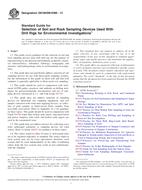 ASTM D6169/D6169M-13..
ASTM D6169/D6169M-13..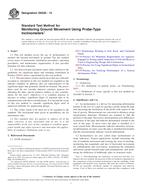 ASTM D6230-13
ASTM D6230-13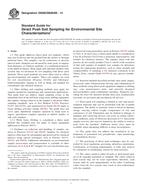 ASTM D6282/D6282M-14..
ASTM D6282/D6282M-14..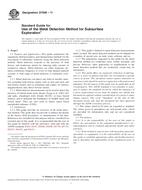 ASTM D7046-11
ASTM D7046-11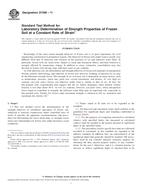 ASTM D7300-11
ASTM D7300-11
 Cookies
Cookies
